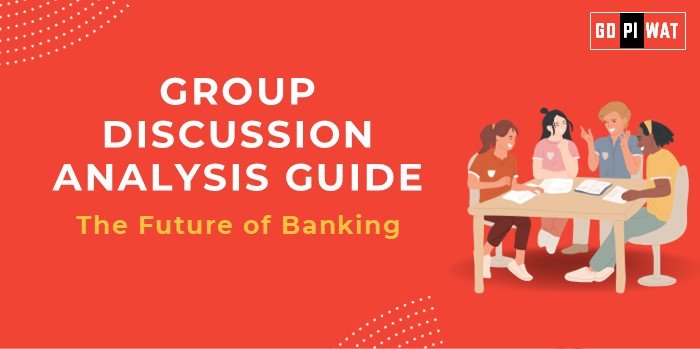📋 Group Discussion (GD) Analysis Guide
🌐 Introduction to the Future of Banking
Opening Context: Banking has seen rapid digital evolution, particularly since the COVID-19 pandemic, shifting consumer habits towards digital-only banks (often called “neobanks”) that operate exclusively online without physical branches.
Topic Background: Digital-only banks leverage advanced tech, such as AI and secure cloud-based solutions, to offer streamlined services and personalized financial management. As traditional banks face rising operational costs and customer demands for digital convenience, digital-only banks are emerging as a cost-efficient alternative with high customer appeal.
📊 Quick Facts and Key Statistics
- 🌍 Global Digital Banking Growth: The global neobank market is expected to reach $394.6 billion by 2026, with a CAGR of 46.5%.
- 📱 Consumer Demand for Digital: 71% of U.S. consumers primarily manage accounts digitally (ABA, 2023).
- 📈 Growth in Mobile Banking: 48% of U.S. consumers now use mobile banking as their primary banking method (ABA).
- 🏢 Decline in Traditional Branches: Over 2,500 U.S. bank branches closed in 2023 (FDIC).
- 💡 Trust as a Key Factor: Only 33% of banking customers feel that their bank knows them well, while 93% want personalized services.
🔍 Stakeholders and Their Roles
- 💳 Digital-Only Banks: Offer consumer-friendly banking options with a focus on low fees, AI-driven personalization, and mobile-first services.
- 🏦 Traditional Banks: Work to modernize legacy systems and adopt digital capabilities to retain customers.
- ⚖️ Regulators (e.g., RBI, FDIC): Set digital banking standards to ensure security, financial stability, and fair practices.
- 🙋 Customers: Increasingly demand digital banking experiences but often still value physical branches for complex transactions and trust.
🏆 Achievements and Challenges
✨ Achievements
- 💰 Cost Efficiency: Digital-only banks save costs by eliminating physical branches, allowing them to offer higher savings yields.
- 📲 Customer Convenience: Streamlined mobile services and AI-driven customer support.
- 🔗 Tech Integration: Seamless payment options and 24/7 service access.
⚠️ Challenges
- 🔒 Trust Issues: Some customers prefer branches due to concerns over digital security.
- 🤖 Customer Service: Digital-only banks may lack human touchpoints, especially during technical issues.
- 📜 Regulatory Hurdles: Adapting to different regulatory environments in each country.
🌍 Global Comparisons
In the UK, digital-only banks have shown success with regulators allowing digital-only licenses, enhancing competition.
📚 Case Studies
India’s neobanks like Fi Money have found success by targeting niches, such as freelancers and SMEs, but remain limited by regulatory requirements for traditional partnerships.
💡 Structured Arguments for Discussion
- ✔️ Supporting Stance: “Digital-only banks offer an unmatched combination of convenience, low fees, and tailored experiences, positioning them as the future of banking.”
- ❌ Opposing Stance: “While innovative, digital-only banks struggle with trust and security concerns, making traditional banks essential for customers seeking stability.”
- ⚖️ Balanced Perspective: “Digital-only banks are transforming the industry, but a hybrid model that combines digital innovation with in-person support may be the answer.”
📈 Effective Discussion Approaches
📢 Opening Approaches
- 📊 Fact-Based Start: “With mobile banking as the primary method for 48% of Americans, digital-only banks are well-positioned to capture the market’s shift towards digital.”
- ⚖️ Contrast Start: “Digital-only banks may be the future, but the 38% of customers who find branches essential illustrate the ongoing need for traditional banks.”
🔄 Counter-Argument Handling
Reference examples of digital-only banks building trust through robust security measures or partnerships with traditional banks.
📊 Strategic Analysis of Strengths and Weaknesses
- ✅ Strengths: Cost-efficiency, convenience, customer personalization.
- ⚠️ Weaknesses: Limited customer trust, lack of physical support, regulatory challenges.
- 🌟 Opportunities: Financial inclusion, partnerships with traditional banks, evolving customer behaviors.
- ⚡ Threats: Security risks, competition from traditional banks adopting digital services.
🎓 Connecting with B-School Applications
📚 Real-World Applications
Financial modeling for neobanks, customer experience innovations, and digital transformation strategy.
💬 Sample Interview Questions
- 🤔 “How can digital-only banks overcome customer trust issues?”
- ⚖️ “What regulatory challenges do neobanks face in emerging markets like India?”
📘 Insights for B-School Students
Consider customer behavior analytics, risk management in digital banking, and how neobanks’ business models are impacting traditional banking.
s


